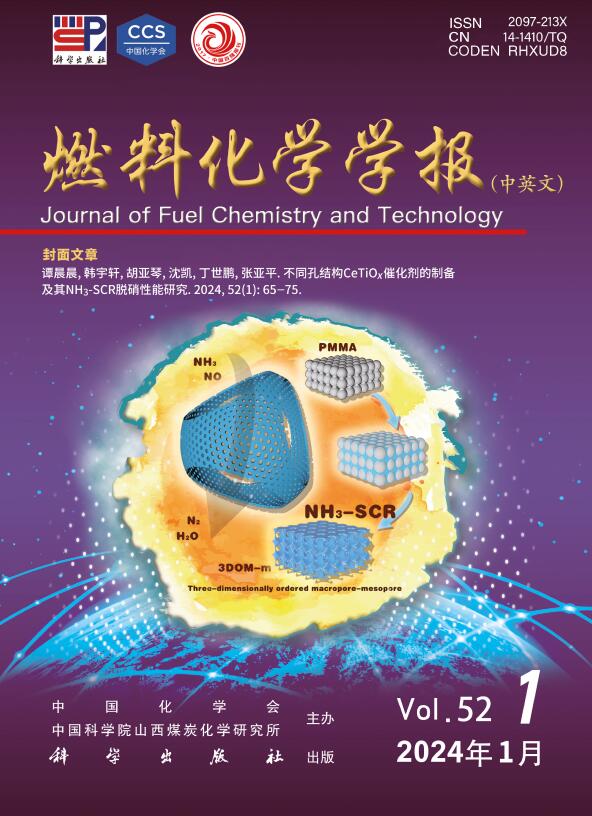Elucidating the catalytic role of lithium (Li) in the glucose-to-fructose isomerization over Li-C3N4 catalyst at 60 °C in water
Q3 Energy
引用次数: 0
Abstract
Fully utilizing renewable biomass energy is important for saving energy, reducing carbon emissions, and mitigating climate change. As the main hydrolysate of cellulose, a primary component of lignocellulose, glucose could be employed as a starting material to prepare some other functional derivatives for improving the value of biomass resources. The isomerization of glucose to produce fructose is an important intermediate process during numerous high-value-added chemical preparations. Therefore, the development of efficient and selective catalysts for glucose isomerization is of great significance. Currently, glucose isomerase catalysts are limited by the harsh conditions required for microbial activity, which restricts further improvements in fructose yield. Additionally, heterogeneous Brønsted-base and Lewis-acid catalysts commonly employed in chemical isomerization methods often lead to the formation of undesirable by-products, resulting in reduced selectivity toward fructose. This study has demonstrated that lithium-loaded heterogeneous catalysts possess excellent isomerization capabilities under mild conditions. A highly efficient Li-C3N4 catalyst was developed, achieving a fructose selectivity of 99.9% and a yield of 42.6% at 60 °C within 1.0 h—comparable to the performance of the enzymatic method. Characterization using X-ray photoelectron spectroscopy (XPS), X-ray diffraction (XRD), proton nuclear magnetic resonance (1H NMR), and inductively coupled plasma (ICP) analyses confirmed that lithium was stably incorporated into the g-C3N4 framework through the formation of Li−N bonds. Further investigations using CO2 temperature-programmed desorption (CO2-TPD), in situ Fourier-transform infrared spectroscopy (FT-IR) and 7Li magic angle spinning nuclear magnetic resonance (7Li MAS NMR) indicated that the isomerization proceeded via a base-catalyzed mechanism. The Li species were found to interact with hydroxyl groups generated through hydrolysis and simultaneously coordinated with nitrogen atoms in the C3N4 matrix, resulting in the formation of Li-N6-H2O active sites. These active sites facilitated the deprotonation of glucose to form an enolate intermediate, followed by a proton transfer step that generated fructose. This mechanism not only improved the efficiency of fructose production but also provided valuable insight into the catalytic role of lithium within the isomerization process.
研究了锂(Li)在60℃水溶液中Li- c3n4催化剂上对葡萄糖-果糖异构化的催化作用
充分利用可再生生物质能,对节约能源、减少碳排放、减缓气候变化具有重要意义。作为木质纤维素的主要成分纤维素的主要水解产物,葡萄糖可以作为原料制备其他功能衍生物,以提高生物质资源的价值。葡萄糖异构化制果糖是许多高附加值化学制剂的重要中间过程。因此,开发高效、选择性的葡萄糖异构化催化剂具有重要意义。目前,葡萄糖异构酶催化剂受到微生物活动所需的苛刻条件的限制,这限制了果糖产量的进一步提高。此外,化学异构化方法中常用的多相Brønsted-base和Lewis-acid催化剂通常会导致不良副产物的形成,导致对果糖的选择性降低。本研究表明,负载锂的非均相催化剂在温和条件下具有优异的异构化能力。开发了一种高效的Li-C3N4催化剂,在60°C条件下,1.0 h内的果糖选择性为99.9%,产率为42.6%,与酶法的性能相当。利用x射线光电子能谱(XPS)、x射线衍射(XRD)、质子核磁共振(1H NMR)和电感耦合等离子体(ICP)分析证实,锂通过形成Li−N键稳定地结合到g-C3N4骨架中。利用CO2程序升温解吸(CO2- tpd)、原位傅里叶变换红外光谱(FT-IR)和7Li魔角自旋核磁共振(7Li MAS NMR)进一步研究表明,异构化是通过碱催化机制进行的。在C3N4基质中,Li与水解生成的羟基相互作用,同时与氮原子配位,形成Li- n6 - h2o活性位点。这些活性位点促进葡萄糖的去质子化,形成烯酸酯中间体,然后是质子转移步骤,产生果糖。这一机制不仅提高了果糖生产的效率,而且为锂在异构化过程中的催化作用提供了有价值的见解。
本文章由计算机程序翻译,如有差异,请以英文原文为准。
求助全文
约1分钟内获得全文
求助全文
来源期刊

燃料化学学报
Chemical Engineering-Chemical Engineering (all)
CiteScore
2.80
自引率
0.00%
发文量
5825
期刊介绍:
Journal of Fuel Chemistry and Technology (Ranliao Huaxue Xuebao) is a Chinese Academy of Sciences(CAS) journal started in 1956, sponsored by the Chinese Chemical Society and the Institute of Coal Chemistry, Chinese Academy of Sciences(CAS). The journal is published bimonthly by Science Press in China and widely distributed in about 20 countries. Journal of Fuel Chemistry and Technology publishes reports of both basic and applied research in the chemistry and chemical engineering of many energy sources, including that involved in the nature, processing and utilization of coal, petroleum, oil shale, natural gas, biomass and synfuels, as well as related subjects of increasing interest such as C1 chemistry, pollutions control and new catalytic materials. Types of publications include original research articles, short communications, research notes and reviews. Both domestic and international contributors are welcome. Manuscripts written in Chinese or English will be accepted. Additional English titles, abstracts and key words should be included in Chinese manuscripts. All manuscripts are subject to critical review by the editorial committee, which is composed of about 10 foreign and 50 Chinese experts in fuel science. Journal of Fuel Chemistry and Technology has been a source of primary research work in fuel chemistry as a Chinese core scientific periodical.
 求助内容:
求助内容: 应助结果提醒方式:
应助结果提醒方式:


